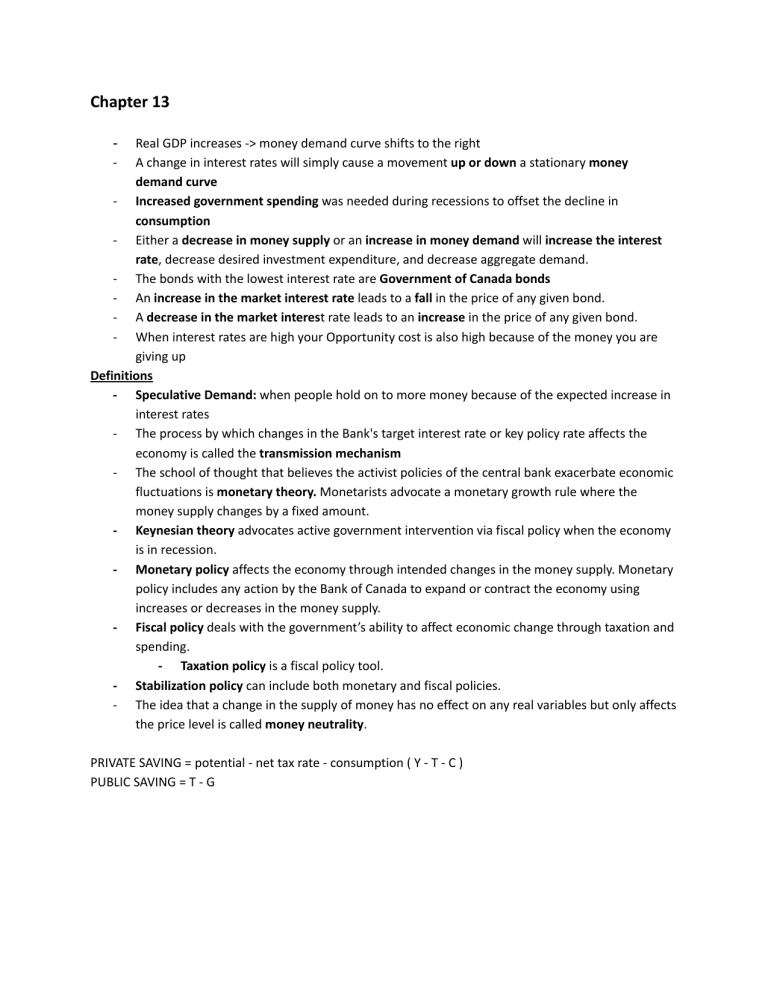
Chapter 13 - Real GDP increases -> money demand curve shifts to the right A change in interest rates will simply cause a movement up or down a stationary money demand curve - Increased government spending was needed during recessions to offset the decline in consumption - Either a decrease in money supply or an increase in money demand will increase the interest rate, decrease desired investment expenditure, and decrease aggregate demand. - The bonds with the lowest interest rate are Government of Canada bonds - An increase in the market interest rate leads to a fall in the price of any given bond. - A decrease in the market interest rate leads to an increase in the price of any given bond. - When interest rates are high your Opportunity cost is also high because of the money you are giving up Definitions - Speculative Demand: when people hold on to more money because of the expected increase in interest rates - The process by which changes in the Bank's target interest rate or key policy rate affects the economy is called the transmission mechanism - The school of thought that believes the activist policies of the central bank exacerbate economic fluctuations is monetary theory. Monetarists advocate a monetary growth rule where the money supply changes by a fixed amount. - Keynesian theory advocates active government intervention via fiscal policy when the economy is in recession. - Monetary policy affects the economy through intended changes in the money supply. Monetary policy includes any action by the Bank of Canada to expand or contract the economy using increases or decreases in the money supply. - Fiscal policy deals with the government’s ability to affect economic change through taxation and spending. - Taxation policy is a fiscal policy tool. - Stabilization policy can include both monetary and fiscal policies. - The idea that a change in the supply of money has no effect on any real variables but only affects the price level is called money neutrality. PRIVATE SAVING = potential - net tax rate - consumption ( Y - T - C ) PUBLIC SAVING = T - G NATIONAL SAVING = Y - C - G A decrease in the money supply causes an increase in interest rates. In the short-run, what is the effect on the quantity of investment? Investment decreases. (Cash reserves + deposits at the bank of canada) / (all deposits labeled) for bank’s actual reserve ratio ECON REVIEW CLASS CPI Unemployment = population * participation rate * unemployment Appreciation = shuts AE curve down because imports increase exports decrease (shift down and rotation down) AE = C + I + G + X - IM - When spending = output; AE = GDP, equilibrium - Transfer payments act to reduce tax rate which in turn increase consumption AE = 200 + 250 + 300 + 150 + (0.7 x (1-0.2) - 0.3) Y Solve for y. If the price level increases you can buy less with what you have i.e consumption decreases. Imports - exports (net decreases) since people wanna import more Simple multiplier and multiplier are short-run concepts (long-run is equal to 0) - Autonomous increase, AD moves right - SM = (Y1 - Y0) / change in autonomous spending (investment, government spending, exports) - How much does income change when we take into the price change - M = Y2 (equilibrium of AS and AD) - Y0 / change in autonomous - If aggregate supply curve is flat, prices aren’t flat and both M and SM are the same - If aggregate supply is steep, then the multiplier is close to 0 Company operating at capacity -> AS is steep Think of AS with recession and boom - Wages start to rise and AS shifts left. - Automatic adjustment curve always works through the AS curve Automatic = AS moving Fiscal and monetary policy = AD moving w Savings and investments - National Savings = Y* - C - G - Investment demand Reference to economic growth is always a long run concept If bank of canada sells government bonds -> money supply decreases The lower interest rate means a lower opportunity cost for holdingmoney, so people choose to hold more money and fewer bonds. When people don’t want money, bonds are more attractive When interest rates are low, you are not foregoing much interest that you could be earning so you will not be as concerned about keeping your money working for you. Money demand will therefore be high when interest rates are low. If it doesn’t cause an output gap, it causes the bank to do nothing When gdp goes up people demand more money When price goes down people demand less money





